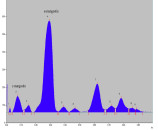Optimisation of Extraction and TLC-Densitometric Analysis of α- and γ-Mangostin from the Rind of Garcinia mangostana L http://www.doi.org/10.26538/tjnpr/v7i3.9
Main Article Content
Abstract
Mangosteen (Garcinia mangostana L.) is a plant from Southeast Asia, including Indonesia,
Malaysia, Thailand, and Myanmar, commonly used in traditional medicine. This study aims to
determine the best solvent for the extraction of α-mangostin and γ-mangostin and develop a
validated analytical method for simultaneously determining both compounds. The dried rind of G.
mangostana (500 mg) was extracted with ethanol, ethyl acetate, and acetone by percolation. The
percolates were evaporated to obtain viscous crude extracts. The TLC-densitometry technique was
employed to determine the content of α-mangostin and γ-mangostin in the extracts.
Chromatographic identification of the contents was carried out on a silica gel TLC plate (GF254)
with a mobile phase of chloroform: ethyl acetate: hexane: formic acid (5:2:3:1) using standard αmangostin and γ-mangostin as reference compounds. The method has satisfactory linearity and
meets the criteria for precision and accuracy at concentrations of 100 – 500 µg/spot for αmangostin and 200 – 500 µg/spot for γ-mangostin. The results showed that ethyl acetate extract
had the highest concentration of α-mangostin and γ-mangostin at 3.05±0.22% and 0.22±0.15%,
respectively. The TLC-densitometry technique is suitable and practical for the simultaneous
routine analysis of α-mangostin and γ-mangostin in G. mangostana rind extract.
Keywords: mangosteen rind extract, mangostin, percolation, TLC-Densitometry
Downloads
Article Details

This work is licensed under a Creative Commons Attribution-NonCommercial-NoDerivatives 4.0 International License.
References
Mohd W, Ahmad-hashim FH, Nabihah S, Jaafar S. Valorization of mangosteen, "The Queen of Fruits," and new advances in postharvest and in food and engineering applications : A review. J Adv Res [Internet]. 2019;20:61– 70. Available from: https://doi.org/10.1016/j.jare.2019.05.005
Hermawan JA, Uzmayana RA, Rizqiawan A, Widyowati R, Tran TT. Viability of α -mangostin and Lipopolysaccharide ( LPS ) in 7F2 Cells. Trop J Nat Prod Res. 2023;7(January):2234–6.
Anam K, Munandar R, Wulandari ON, Lestari AB, Farada RE, Hudiyanti D, et al. Chemical Composition, Antioxidant Activities, nd Total Phenolic Content of Combination of Mangosteen ( Garcinia mangostana L .) Peel-Kodavan ( Centella asiatica. Trop J Nat Prod Res. 2023;7(January):2222–8.
Muchtaridi M, Puteri NA, Milanda T, Musfiroh I. Validation analysis methods of α-mangostin, γ-mangostin and gartanin mixture in Mangosteen Garcinia mangostana L.) fruit rind extract from west java with HPLC. J Appl Pharm Sci. 2017;7(10):125–30.
Saifudin A. Isolation , Identification , Validation of Determination Alpha Mangosteen on Mangosteen Rind (Garcinia mangostana L .). Eur J Mol Clin Med. 2020;07(09):1941–7.
Pedraza-chaverri J, Cárdenas-rodríguez N, Orozco-ibarra M, Pérez-rojas JM. Medicinal properties of mangosteen (Garcinia mangostana). Food Chem Toxicol [Internet]. 2008;46(10):3227–39. Available from: http://dx.doi.org/10.1016/j.fct.2008.07.024
Ovalle-magallanes B, Eugenio-pérez D, Pedraza-chaverri J. Medicinal properties of mangosteen (Garcinia mangostana L.): A comprehensive update. Food Chem Toxicol [Internet]. 2017; Available from: http://dx.doi.org/10.1016/j.fct.2017.08.021
Nugroho A. Buku Ajar: Teknologi Bahan Alam. 2017.
Kusmayadi A, Adriani L, Abun A, Muchtaridi M, Tanuwiria UH. The effect of solvents and extraction time on total xanthone and antioxidant yields of mangosteen peel (Garcinia mangostana L.) extract. Drug Invent Today. 2018;10(12):2572– 6.
AOAC. AOAC Guidelines for Single Laboratory Validation of Chemical Methods for Dietary Supplements and Botanicals. 2002. p. 1–38.
FDA. Bioanalytical Method Validation Guidance for Industry. 2018.
ICH. Guidance for Industry Q2B Validation of Analytical Procedures: Methodology [Internet]. Vol. 20857. 1996. Available from: http://www.fda.gov/cder/guidance/index.htm%5Cnhttp://w ww.fda.gov/cber/guidelines.htm


